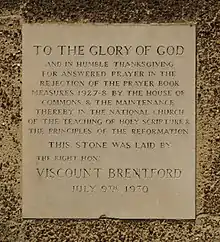Book of Common Prayer (1928)
The Book of Common Prayer (1928) was a revised version of the 1662 Book of Common Prayer of the Church of England. The proposed revision was approved in 1927 by the Church Assembly but rejected by Parliament. Its authorisation was defeated in the House of Commons for a second time on 14 June 1928.

In order to reduce conflict with traditionalists, it was decided that the form of service to be used would be determined by the Incumbent and the Parochial Church Council, with the older 1662 forms of services continuing to be available alongside the 1928 forms.[1]
Since the Church of England Assembly (Powers) Act 1919 required measures affecting the Book of Common Prayer to be approved by Parliament before receiving royal assent, the measure authorising its use, together with an annexed copy (a "Deposited Book"), was submitted to Parliament. The House of Lords approved the Book by a large majority, but the corresponding resolution in the House of Commons was defeated by 33 votes on 15 December 1927. The Home Secretary William Joynson-Hicks (later Viscount Brentford) and Rosslyn Mitchell "reached and inflamed all the latent Protestant prejudices in the House" and argued strongly against it, largely in opposition to the "Roman" practice of reservation of sacrament which the Book would have legalised in the Church of England, albeit in a limited fashion and for the specific purpose of communion of the sick only.[1][2][3]
The prayer book was submitted again the following year and defeated a second time in the Commons on 14 June 1928.[4]
In response to this rejection, the bishops issued a unanimous statement, asserting the Church of England's right to order its forms of worship and, in 1929, the Upper House of the Convocation of Canterbury resolved that bishops might approve the use of the 1928 book, notwithstanding the lack of parliamentary authority. The 'Shorter Prayer Book', published in 1946 with a preface by the archbishop of Canterbury Geoffrey Fisher, contained services from the 1662 book with alternative material from the 1928 book in parallel columns. The 1928 revised forms of Matrimony and Baptism were quite widely adopted, but those of other rites tended not to be; the consequence, in practice, being very wide variation in liturgical practice from parish to parish, with very few clergy adhering consistently to the strict observation of either the 1662 or the 1928 forms of worship.
In 1966, with some changes, many services from the 1928 book were authorised as legal for public worship, as the First Series of Alternative Services, and subsequently continued in use through authorisation by inclusion in the Alternative Service Book and its successor, Common Worship.[5]
References
- "PRAYER BOOK MEASURE, 1927. (Hansard, 15 December 1927)". api.parliament.uk. Retrieved 2018-07-11.
- Machin, G. I. T. (2008). "Parliament, the Church of England, and the Prayer Book Crisis, 1927-8". Parliamentary History. 19 (1): 131–147. doi:10.1111/j.1750-0206.2000.tb00449.x. ISSN 0264-2824.
- "1928 Proposed Book of Common Prayer: Visitation & Communion of the Sick". justus.anglican.org. Retrieved 2018-07-11.
- "PRAYER BOOK MEASURE, 1928. (Hansard, 14 June 1928)". api.parliament.uk. Retrieved 2018-07-11.
- "Where the liturgy comes from | The Church of England". www.churchofengland.org. Retrieved 2018-07-11.